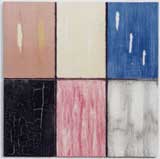Reprinted with permission from Custom Woodworking Business.
Some easy techniques for producing today’s popular looks.
By Mac Simmons
The popularity of antiqued, time-worn looks in today’s casegoods has created a new challenge for finishers — to make new finishes look old. There are several relatively easy techniques to achieve an antique appearance.
One way to age wood is to use lye (sodium hydroxide), a caustic chemical that will change wood’s color, texture and appearance. A second method is thrashing and beating the wood, which leaves an antique distressed look. A third way is to place the wood outdoors or bury it in the earth, exposing it to the natural elements.
However, today most aged finishes are being done with color painted coatings. The colors are usually chosen to match or coordinate with surrounding colors in the room or area. The aging techniques allow several colors to be included in the finish, making them more decorative and ideal for doing custom colors for customers. They can enhance many types of projects, including furniture, paneling, flooring, doors, wainscoting, beams, ornaments and other furnishings.
Getting Underway
In finishing, you must always start out with a clean, well-sanded substrate. Any residue that remains on the surface can cause adhesion or other finishing problems between the coatings and the substrate.
As with all new finishing techniques, you should make up samples to see how the technique will work for you. I also suggest you keep records of how you complete each sample. Completed samples should include the final coatings — you cannot tell the true finish color until you have clear-coated it.
If you are using open grained woods and want a full finish, like a glossy piano, you should start with a primer sealer, paste wood filler or gesso paste filler. Once you have the grains filled, you are ready for finishing.
You may want to begin with a multi-color aging finish. Select colors that will complement the decor of the room in which the project will be placed or current popular colors. Apply the first color coat and allow it to dry; then apply the second color. After the final color has been applied and thoroughly dried, you can start sanding through the color coatings.
Depending on the coating you use, select sandpaper grits that will cut through it without leaving deep scratches. It is better to spend a little more time sanding and have a smooth surface than to try to save time and not do an adequate sanding job. Using coarser sandpaper will leave deeper scratches in the finish and create a look of naturally worn-down coatings (see the blue sample shown in the upper right-hand corner of the photo below).

Start by sanding a few scattered areas until the second color applied shows through. Then, in several other spots, sand down to the first color applied. Continue sanding until you have all your colors showing in different areas. You do not want to overdo the sanding with too many sand throughs, otherwise your finish will not look authentic. You should space out and randomly sand through on larger areas; on smaller areas, a few lightly sanded areas will suffice.
You can sand freehanded with sanding blocks or use an electric or air sanders. Vary the patterns of the sand throughs by alternating with the flat surface and the front and back edges of the sanders. Using different shaped sanding patterns will make it look more natural and interesting.
Do not sand too aggressively unless you intentionally want to sand into the wood. On some coatings, you may want to try wet sanding the dry coatings with water. Once your sanding is done, wipe or blow off the sanding dust and begin applying clear coats to the aged finish.
Additional Aging Methods
There are other materials that can be used in the aging procedure. One is petroleum jelly, another is candle wax. These are wiped or rubbed onto the first color coat in random spots. Then a second color paint is applied and allowed to dry. Remove the wax or petroleum jelly by rubbing with a cloth or paper towels, or scrape the areas lightly with a paint scraper. This allows the lower color to show through. Then wipe the rubbed areas with a cloth and mineral spirits to dewax the painted surface. Afterwards you can apply your final clearcoats.
You also may want to try using a crackle medium, which can be purchased at most paint stores or arts and craft stores. Apply your first color coat of a flat latex paint and dry completely. Then randomly apply the crackle medium with a brush. Allow the medium to set up, but not cure. Apply a second color of latex paint and allow it to crackle and dry thoroughly. You can then apply your clearcoats.
Another aging technique is to apply a first coat of color, allow it to dry, then thin out a second color to a watery wash or a glaze. Apply the washed-out color over the first color basecoat. Once dry, apply your clear coats.
You also can apply the base color, allow it to dry and apply a wash/glaze for the second color. Then take a sponge or cloths dampened with the proper clean-up solvent and randomly wipe out some of the color. Allow it to dry and apply the clearcoat.
In addition, various colored glazes will give your work an aged appearance (see the glazing on the gold and silver masks featured in the photo above). “Flyspecking” various sized dots and distressing markings also can enhance an aged finish (see photo above).
The popular aged finishes are actually quite easy to do, although it takes some practice. However, once you get the right touch and timing of the materials, you will have vastly broadened your range of finishes.
Reprinted with permission from Custom Woodworking Business.